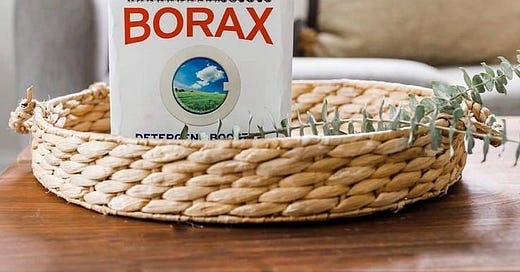Why Big Pharma Wants Borax’s Healing Benefits Suppressed?
Borax: a suppressed mineral remedy for arthritis, osteoporosis, and more...
Struggling with low energy? I created a mini-guide that contains five simple, no-cost steps to improve your health in just 72 hours.
Click here and download a free “72-Hour Health Reset: 5 Free Steps” guide.
Borax is a naturally occurring mineral known as sodium tetraborate, and it has been used for centuries as a household cleaner and insecticide.
However, Borax is also a powerful health remedy, particularly for arthritis, osteoporosis, and fluoride toxicity, and it has been largely overlooked and suppressed.
It’s mined from dried salt lakes in places like California and Turkey. Borax is a source of boron, a trace mineral that is very important for human health.
Despite its benefits, regulatory restrictions and pharmaceutical interests have limited its availability, and this has raised questions about how to access and use this affordable remedy.
This article will explain borax’s health benefits, scientific and anecdotal evidence, and the controversy surrounding its use.
And at the end, I will explain how to use borax, a medicine that will cost you only a few cents a month, literally.
What Is Borax?
Borax, chemically sodium tetraborate decahydrate, contains 11.3% boron and is typically sold as a 99-99.5% pure technical or agricultural grade product, safe for both household and health applications.
When ingested, borax reacts with stomach acid to form boric acid and sodium chloride, with boron compounds rapidly excreted in urine.
Unlike boric acid, which has a higher boron content (17.5%) and was once used as a food preservative, borax is strongly alkaline (pH 9-10), and it has antiseptic and antifungal properties.
Boron is present in plants and unprocessed foods, but modern diets, chemical fertilizers, and cooking practices have reduced intake to 1-2 mg/day in developed countries, compared to 5-8 mg in regions with boron-rich soils.
Health Benefits of Boron
Boron is essential for healthy cell walls, signal transmission, and parathyroid function, which regulates the metabolism of calcium, magnesium, and phosphorus.
Deficiency can lead to overactive parathyroids, causing excessive calcium release from bones and teeth, contributing to arthritis, osteoporosis, tooth decay, and soft tissue calcification.
Boron also:
supports hormone balance
increases testosterone in men
increases estrogen in postmenopausal women
enhances vitamin D activation (which promotes bone health)
Its antifungal and antiviral properties make it effective against Candida, vaginal thrush, and toe fungus, it can also bind and excrete fluoride, and fluoride causes joint and brain damage.
The story of borax as a health remedy gained traction in the 1960s when Dr. Rex Newnham, a soil scientist in Western Australia, cured his arthritis with 30 mg/day of borax.
He noticed boron deficiency in local plants and linked it to human health.
His findings, which were ignored by medical authorities, led to a double-blind trial in the 1980s at Royal Melbourne Hospital, where 70% of arthritis patients improved on borax compared to 12% on placebo.
Newnham’s research also correlated soil boron levels with arthritis rates: Jamaica, with low boron intake (<1 mg/day), has a 70% arthritis prevalence; the U.S., with 1-2 mg/day, has 20-30%; and Israel, with 5-8 mg/day, has less than 1%.
Borax is beneficial for rheumatoid arthritis, juvenile arthritis, lupus, osteoporosis, and fluoride-related conditions like fibromyalgia and chronic fatigue.
Scientific and Anecdotal Evidence
Newnham’s work is supported by studies showing boron’s impact on bone health and hormone levels.
A 2011 review highlighted boric acid’s efficacy against drug-resistant Candida, while a Chinese study found borax effective for skeletal fluorosis, with 50-80% improvement in patients taking 300-1100 mg/day over three months.
Anecdotal reports from forums like Earth Clinic describe relief from arthritis, psoriasis, and toe fungus.
One user reported knee pain vanishing within a day of taking borax, while another cured chronic fibromyalgia after detoxing fluoride with borax and sea salt.
These stories suggest borax’s potential for conditions linked to boron deficiency or fluoride toxicity.
The Controversy: Why Is Borax Suppressed?
Despite its benefits, borax faces significant suppression.
In 1981, Australia classified boron compounds as poisons after Newnham’s arthritis cure gained popularity, fining him for selling a “toxic” substance.
In 2010, the European Union banned borax and boric acid for public sale, and cited reproductive toxicity in high-dose animal studies (e.g., 13.7 mg boron/kg/day reduced fetal weight in rats).
However, human studies, including those of borax workers, show no fertility issues, and borax’s toxicity (LD50: 4,500-6,000 mg/kg) is lower than table salt’s (3,000 mg/kg).
These bans protect pharmaceutical profits, as arthritis and osteoporosis treatments generate billions of dollars a year.
The removal of key borax studies from PubMed and the promotion of more toxic substitutes like sodium percarbonate raise suspicions of industry influence.
Widespread use of borax could reduce reliance on costly drugs, and this threatens the medical-pharmaceutical system.




